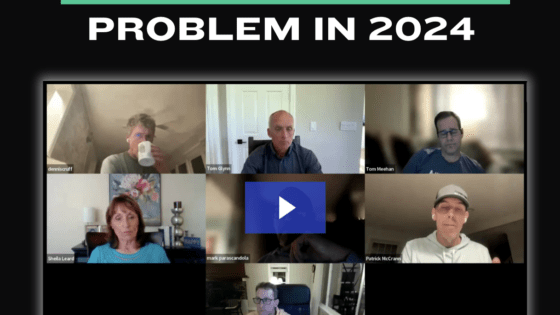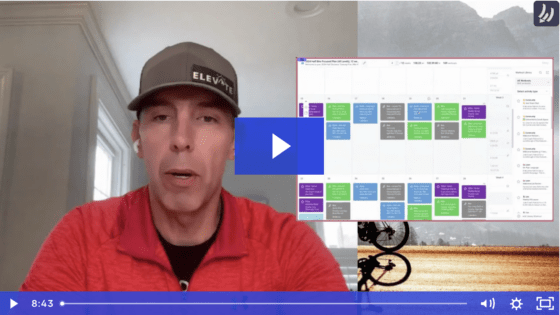We are approaching that time of year when triathletes near their final races of the season and begin to ask themselves “How can I get faster next year?”
We are going to share with you several Off Season lessons we’ve learned after years of coaching age group athletes, with the goal of ultimately helping you to better coach yourself.
Your Two Roles as a Self-Coached Athlete
As coaches, we’ve found ourselves wearing two hats with our athletes:
- Coach = “make me/teach me how to be faster.”
- Time Investment Manager = “Life gives me X hours to train each week. Invest that time to yield the greatest return on race day.”
It’s likely you’ve heard of the Coach role but what is this “Time Investment Manager” jazz? In our experience it’s actually the more important of the two so we’ll save that discussion for Part II. For now, let’s discuss your role as the Coach, as it applies to Off Season training.
The Coach
Off Season Principle #1: Increased speed at shorter distances translates to increased speed at longer distances, assuming you add endurance to that speed at the appropriate time of the season.
For now, let’s drop the scientific terms, the aerobic this, anaerobic that and lactate threshold something else. The simple fact, which we have observed with our own training and through the results of our Team, is that if you make yourself faster at shorter distance, that speed is translated to increased speed at longer distances. This is a fancy way of saying that fast is FAST, everywhere and at all distances.
Think about it:
- You probably know a very fast 5k or 10k runner who can pop out an equally fast half marathon or even a marathon. You may have a roadie friend who, even though he “only” rides about 40 miles to your 80+ on a Saturday, can ride circles around you at will. The reason is simple: if you can improve your 10k time from 50 to 45 minutes, you will also drop your half marathon time from 2:00 to 1:50, or your marathon time from 4:10 to 3:55 (just making these numbers up, folks). Yes, we make the assumption that before you move from 10k training straight into a marathon…you do some marathon training first to put some endurance under that speed!
- This is even more true on the bike: If your roadie friend spends 4-6hrs per week with his tongue in the spokes trying to hang on to the back of a 26-27mph peleton…trust us, he can cruise all day at his 22mph to your 19mph. More importantly, no amount of riding 19mph will magically create the ability to ride 22mph. If you wanna ride fast, you gotta ride fast!
- Finally, the new big names, the up-and-comers in the professional Ironman® ranks, are former short course athletes who are now applying their Ludicrous Speed to long course events. Fast is FAST, at all distances.
You earn the right to go faster on race day by making yourself a faster athlete in training. The best way for the age grouper to do this is to get faster at shorter distances and then transfer this speed over to longer distances by building endurance under this new speed.
“Ok, but when do I build my FAST and when do I shift my focus to building my FAR?”
Off Season Principle #2: Separate FAST from FAR
You’ve probably heard the term “Base Training:” you do lots and lots of aerobic volume, “building a big engine.” Through putting in the time you earn the right to do the fast training, later in your season, that will make you faster. Sounds good on paper but let’s talk about what we’ve observed across thousands of age groupers, just like you:
- Athlete does a lot of easy to steady aerobic volume, building their base fitness.
- About 8-12wks out from their race, the athlete flips the “time to get fast” switch and begins to do speedwork on the bike and run. However….
- At the same time, the requirements of their goal race, especially Ironman, dictate that the training volume also continues to increase.
- The athlete tries to build their FAST at the same time they are building their FAR….and you find them sleeping under their desk at work.
Very simply, there’s what you read in a book and there is what you learn when you apply that book stuff to the real world across many, many people. Our observation is that this Build Base, then Build Speed model falls apart at the Ironman® distance. The combination of fast and far is simply not compatible.
The solution: build your FAST at a time of year when you have no requirement to also build your FAR…in the Out Season!
You have no half Ironman® or Ironman® on the calendar and therefore no requirement for 3-5hr rides, 2hour long runs, etc. Instead, you can apply all of your efforts to going very, very fast for very short distances, and recovering from those efforts, making yourself a much faster runner and cyclist. You exit the Off Season, in about April, dramatically faster than your Last April self…and your This April training partners! You then flip the switch to Building Far as you get closer to your goal races.
We have applied this FAST then FAR model to well over 1000 athletes since 2005. These athletes, training only 5-7hrs total per week for 20 weeks, have achieved the following gains:
- 15% Functional Threshold Power improvement on the bike
- 4:45 half marathon PRs
- 2:30 10k PRs
These gains then form the foundation for massive in-season PR’s, podium finishes and age group wins.
We hope we have begun to challenge your understanding of Off Season training in Part I. In Part II we’ll discuss your most important role: the Time Investment Manager. As a real world age grouper, living, working, and family-ing in the real world, you need to learn how to prioritize your most precious asset: your time!




Leave a Reply